
CHAPEL OF NEW SING SING PRISON
Lewis F. Pilcher, Architect

CHAPEL OF NEW SING SING PRISON
Lewis F. Pilcher, Architect
Collected by
HASTINGS H. HART, LL.D.
President of American Prison Association
Presented at
The FIFTY-SECOND CONGRESS
OF THE ASSOCIATION
DETROIT, OCTOBER, 1922

NEW YORK
RUSSELL SAGE FOUNDATION
1922
Copyright, 1922, by
The Russell Sage Foundation
Wm. F. Fell Co. Printers
PHILADELPHIA, PA.
| PAGE | |
| Introduction. By Hastings H. Hart, LL.D. | 7 |
| A Skyscraper Jail. A Possible Solution of the Cook County Jail Problem. By Hastings H. Hart | 9 |
| The New Sing Sing Prison. | 16 |
| The Clinic Building at the New Sing Sing Prison. By Walter B. James, M.D. | 16 |
| Psychiatric Classification in Prison. By Lewis F. Pilcher, New York State Architect | 18 |
| The Wingdale Prison. By Lewis F. Pilcher, New York State Architect | 27 |
| Kilby Prison. | |
| Preliminary Note. By Hastings H. Hart | 30 |
| Notes on the Design and Construction of Kilby Prison. By Martin J. Lide, Engineer and Architect | 31 |
| Prison Farms for Women. By Hastings H. Hart | 38 |
| State Farm for Women at Niantic, Connecticut | 38 |
| The Caroline Bayard Wittpenn Cottage at the New Jersey State Reformatory for Women | 42 |
| Proposed Plans for a State Prison. By Alfred Hopkins, Architect | 45 |
| Proposed Plan for a Reformatory. By Alfred Hopkins, Architect | 46 |
| Westchester County Penitentiary and Workhouse, White Plains, N. Y. By Alfred Hopkins, Architect | 47 |
| Proposed Plans of the Detroit House of Correction. By Albert Kahn, Architect | 55 |
| Reception Cottage at the Hawthorne School (for Delinquent Boys). By Hastings H. Hart | 59 |
| One-Story Cottage at the Thorn Hill School (for Delinquent Boys). By Hastings H. Hart | 61 |
| PAGE | |
| Chapel of New Sing Sing Prison. | Frontispiece |
| A Skyscraper Jail. | |
| A Plan for a Metropolitan Jail | 9 |
| Administration Floor Plan | 11 |
| Typical Cell Floor Plan | 13 |
| Hospital and Clinics—Floor Plan | 15 |
| The New Sing Sing Prison, Ossining, New York. | |
| Psychiatric Building | 17 |
| Typical Detail of Construction of All Buildings | 19 |
| Outside Cell Building—North Elevation | 20 |
| Outside Cell Building—First Floor Plan | 21 |
| Detention Building—First Floor Plan | 22 |
| Detention Building—South Elevation | 23 |
| Mess Hall and Kitchen Building—Basement | 24 |
| Mess Hall and Kitchen Building—First Floor | 25 |
| Wingdale Prison, Wingdale, New York. | |
| General View | 28 |
| Kilby Prison, Montgomery, Alabama. | |
| Front Elevation | 30 |
| General Plan | 32 |
| Administration Building—Floor Plan | 33 |
| Cell Blocks—Floor Plan | 35 |
| Laundry, Bath and Detention Building—Floor Plans | 36 |
| Connecticut State Farm for Women, Niantic, Connecticut. | |
| Perspective of Reception Building | 38 |
| Reception Building—First Floor Plan | 39 |
| Reception Building—Second Floor Plan | 40 |
| Reception Building—Basement Plan | 41 |
| Caroline Bayard Wittpenn Maternity Cottage, State Reformatory for Women, Clinton, New Jersey. | |
| South Elevation | 42 |
| Maternity Cottage—First Floor Plan | 43 |
| Maternity Cottage—Second Floor Plan | 44 |
| Proposed State Prison. | |
| Photograph | 45 |
| Proposed State Prison—Plan | 45 |
| Proposed Reformatory Plan. | 46 |
| Westchester County, New York, Penitentiary and Workhouse. | |
| General View from Approach | 47 |
| Administration Building—Entrance Side | 48 |
| Administration Building—First and Second Floor Plans | 49 |
| Typical Floor Plans of Cell Blocks | 50 |
| Elevations of Corridor and Cell | 51 |
| Ground Plans of Corridors and Cells | 51 |
| Recreation Corridor | 52 |
| Stair Hall—Administration Building | 53 |
| View of Mess Hall from Corridor | 53 |
| Cell Block Corridor | 54 |
| Typical Cell | 54 |
| Detroit House of Correction. | |
| First Floor Plan | 56 |
| Second Floor Plan | 57 |
| Third Floor Plan | 58 |
| Hawthorne School (For Delinquent Boys), Hawthorne, N. Y. | |
| Reception Cottage | 59 |
| Reception Cottage—First Floor Plan | 60 |
| Reception Cottage—Second Floor Plan | 60 |
| Thorn Hill School (for Delinquent Boys), Warrendale, Pennsylvania. | |
| One-story Cottage—Floor Plan | 61 |
| One-story Cottage. Photograph | 62 |
Prison building has been for the most part suspended during the past seven years. State prisons have been under construction at Bellefonte, Pennsylvania; Sing Sing, New York; Statesville, near Joliet, Illinois; and Montgomery, Alabama. Westchester County, New York, has built and Detroit, Michigan, has begun a prison for short term misdemeanants. New York City and the District of Columbia have partially completed reformatories for young men. New reformatories for women have been established in Arkansas, California, Connecticut, Iowa, Kansas, Maine, Minnesota, Missouri, Nebraska, New Jersey, Ohio, Pennsylvania, and Wisconsin. Most of them have adopted cottage plans similar to those of industrial schools for delinquent girls. All of them are in process of development. Most of them have erected from one to three new buildings and are making use of old farmhouses as temporary cottages.
Comparatively few new county jails have been built. Probably the most notable one built in the past seven years is the Hamilton County Jail in Cincinnati, which is reported as a modern and model jail, located in the top of the Court House, like the jails in Philadelphia, Minneapolis, Oakland, California, and Raleigh, North Carolina. Plans for a new county jail system at Chicago for Cook County are being worked out by a local committee which has retained Dr. George W. Kirchwey, of New York, as expert adviser.
From the newer prisons, a selection of noteworthy plans and illustrations is presented herewith. They have been selected with special reference to unusual or improved features, such as modern cell houses, clinical laboratories, improved lighting, and sanitation. The plans selected include state prisons in New York and Alabama and tentative plans for a state prison and a state reformatory; plans for single buildings at two reformatories for women; plans for cottages at two reformatories for boys, and tentative plans for a metropolitan jail designed by the writer with special reference to the needs of Chicago.
It was desired to include the plans of the projected prisons of Ohio, Pennsylvania, and Illinois, but it was found impracticable. Elaborate plans were made and published some years ago for a new Ohio Penitentiary, but building has not commenced and it is understood that the plans will be abandoned or greatly modified. The new state penitentiary at Bellefonte, Pennsylvania, which is to supersede both the Eastern and Western Penitentiaries and to provide for 4,000 to 5,000 prisoners on a farm of over 5,000 acres, was begun ten years ago; but its development was hindered by the war, and thus far temporary provision has been made for about 500 prisoners. Construction is now proceeding rapidly. The ultimate plans are still in process of development.
The state of Illinois is erecting a great penitentiary, designed by Zimmerman, Saxe and Zimmerman, Architects, about six miles from the old prison site. It is intended to accommodate about 2,000 prisoners. Two cell buildings have been erected, each containing 248 cells. The cells are 6½ feet wide, 10 feet 8 inches long and 8 feet high, and are intended to house but one prisoner.
The cell houses are circular, resembling a gas tank with a conical roof. They are a practical execution of the “Panopticon” proposed by Jeremy Bentham in the year 1787, a plan of which will be found in Punishment and Reformation, by Dr. Frederick Howard Wines, page 144. The interior wall of each cell is of glass and a central tower enables the guard to keep every prisoner under observation every moment, day and night. Each cell is well lighted by an exterior window. An elaborate system of ventilation was installed, but on a recent visit the writer discovered that the cell houses ventilate themselves through the outer windows and the skylight, and the fans were not in use. It is doubtful whether a system of perpetual espionage will find favor with prison administrators, but the experiment is an interesting one.
Special efforts were made to obtain the plans of the new Illinois Penitentiary for this publication, but were unsuccessful.
Hastings H. Hart
By Hastings H. Hart, LL.D.
President of the American Prison Association
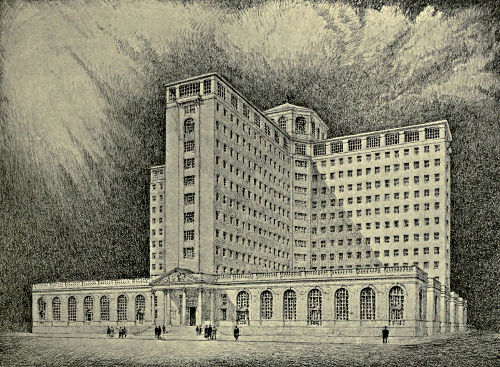
A SKYSCRAPER JAIL
Plan for a Metropolitan Jail Conceived by Hastings H. Hart, President American Prison Association
Designed by Francis Y. Joannes and Maxwell Hyde, Architects
The lower floor represents the Criminal Court Building, which may have any number of stories
County jails are schools of crime, according to prison officials and jail inspectors. They are so constructed and conducted that the prisoners generally come out far worse than they went in.
No metropolitan city of the United States has yet succeeded in constructing a satisfactory jail for the detention of prisoners awaiting trial. The New York City “Tombs” is a gloomy pile, properly described by its name. The ancient Charles Street Jail of Boston has recently been reconstructed at a very large expense, but does not meet the needs of the present day.
The county jail ought to be the most reformatory institution in the land. It receives offenders at the beginning of their careers, before they have become hardened and confirmed criminals. More can be accomplished for the reformation of a young criminal in the first week of his imprisonment than by six months’ confinement in a state prison after he has become a confirmed law-breaker. This was demonstrated by John L. Whitman when he was jailer in the Cook County Jail, where, notwithstanding the most unfavorable conditions, he did wonders for the reclamation of wayward boys and young men.
The utter inadequacy of the Cook County Jail has long been realized by thoughtful people. The Chicago Community Trust, by request of the Board of County Commissioners, has made a Cook County Jail Survey and has organized a committee of representative Chicago citizens for the purpose of abolishing the old Cook County Jail and removing the scandal which has disgraced Cook County for more than fifty years.
In 1919, after the State Board of Public Charities had labored fifty years to reform the county jails, the State Department of Public Welfare made a study of the county jails of Illinois. This report contained the following statement:
“Illinois has 20 county jails which maybe classified as good; 19 as fair; 41 as very poor or bad; 21 as unfit for use. Except for the high standard of cleanliness of the women’s department, it is difficult to find any good points about the Cook County Jail.... It is recognized as an insanitary, dark, overcrowded institution that is a disgrace to Cook County.... They [the prisoners] are locked in their cells from 11.30 in the morning to 3.30 in the afternoon. There are two or three men in each small cell (six by nine feet and eight feet high). It is impossible to distribute the men according to their habits of cleanliness or decency. Twenty hours out of each twenty-four must be spent locked in the insanitary, dirty, crowded cell. All meals are served to the men in their cells. The time for exercise, 9.30-11.30 a. m. and 3.30-5.30 p. m., they stand or walk around or sit down on the floor of the ‘bull pen’ or ‘exercise corridor.’ In the ‘old jail’ this ‘pen’ includes all the floor space of the cell house not occupied by the cell block. It is a big room swarming with men. In the departments of the ‘new’ it is the corridor into which the cells open. The cells are kept locked during the four exercise hours. There are no seats or benches in the ‘bull pens.’ In all departments the pens are crowded during the four ‘exercise’ hours.... Cook County does not furnish jail clothes for prisoners. They have access to laundry tubs once a week. Prisoners wash their own clothes.... Those who do not [have changes of clothing] manage the best way they can. They may wash their clothes, dry them, and put them on again; they may also borrow from cell mates.... There are only 14 shower baths, exclusive of the receiving ward, for all the men prisoners ... (population on the day of inspection, 546).
“One part of the floor space on the dark side of main cell house of the old jail is screened off for a hospital ward. There are no windows in this hospital. The air comes from the ‘old jail.’ It is lighted always by electric light.... The large airy hospital on the eighth floor of the ‘new jail’ is used only for special cases.”
The Committee has retained as adviser with reference to the jail problem Dr. George W. Kirchwey, of New York, formerly Dean of Columbia University Law School, ex-warden of Sing Sing Prison, and a leading expert in penology. He finds all of the evils above mentioned and many others—especially that prisoners are inevitably degenerated in body and soul by the present conditions; that the Cook County Jail, like most county jails, instead of being a preventive, is a prolific source of crime; and that the county bears a heavy burden of expense in detaining prisoners who might better be at large, as is shown by the fact that in many cases, after several months’ detention in the county jail, the prisoner is released by order of the State’s Attorney, either because he is found to be innocent or for lack of sufficient evidence to convict. He finds also that many prisoners are held because they cannot give bail who might safely be at large pending trial, without damage to the community.
Dr. Kirchwey recommends that steps be taken to reduce the jail population: first, by prompt and thorough investigation immediately after arrest, in order to ascertain whether there is sufficient evidence to justify holding the prisoner; second, by so reorganizing the courts as to secure speedy trials and avoid the necessity for long detention; third, by releasing, on their own recognizance without bail, many prisoners who, having families or having regular employment, are not likely to run away.
Dr. Kirchwey regards the present jail site as entirely inadequate. He would prefer to remove the jail to some other part of the city where sufficient ground could be had to provide a suitable yard for outdoor exercise. The present site is only 600 feet square, and it contains both the jail and the Criminal Court Building.
The writer is in the fullest sympathy with the purposes of the Committee and with the principles advocated by Dr. Kirchwey. He agrees with Dr. Kirchwey that women, young prisoners, witnesses, and insane persons should be excluded from the county jail and provided for in separate detention houses. When this is done, however, there will still remain an indefinite number of men, which may be 200, 300, or at times even 500, who must be held in detention awaiting the action of the grand jury or the criminal courts. He believes that suitable provision may be made for these prisoners, in strict accordance with the principles advocated by Dr. Kirchwey, in the manner hereinafter suggested.
The evils in the present Cook County Jail, as pointed out by Dean Kirchwey and his associate, Mr. Winthrop D. Lane, are as follows:
First, insufficient yard space for exercise and separation from the public. The county owns a piece of ground about 600 feet square on which are located the Criminal Court, the old jail, and the “new jail” (built some thirty years ago). To provide a suitable jail yard with room for exercise would require a space at least 1,200 feet square; and even with that space the jail yard must necessarily be dark and be deprived of the free circulation of air because of the proximity of high buildings.
Second, overcrowding, under conditions which make it practically impossible to enlarge the present plant, with the result of confining two or three men in each cell. The jail should be so situated as to permit of enlargement at any time without disturbing its general plan.
Third, lack of classification. It is generally agreed that prisoners ought to be divided into classes according to age, color, criminal experience, condition of health, especially with reference to communicable diseases, and disposition to attempt escape or inflict injury upon officers or other prisoners. Such classification is impossible in a jail of the ancient type which characterizes the present buildings.
Fourth, enforced association with the worst people to be found in the county. The prisoners are released from their cells four hours out of the twenty-four to relieve the bitterness of their confinement under present conditions and to obtain such exercise as they may by moving about in the crowded corridors.
Fifth, lack of employment. The constitutional provision that slavery or involuntary servitude, except for crime, shall not be permitted within the boundaries of the United States is universally construed to mean that unconvicted prisoners cannot be compelled to labor. But such prisoners may be permitted to labor, to their own great benefit; and the jail should be so constructed as to make it possible to provide workshops where prisoners may labor voluntarily at simple employments with proper compensation. An admirable example of the possibility of such employment is found in the Indiana State Prison at Michigan City in the department for insane prisoners who formerly stagnated in the insane wards but who are now diligently, profitably, and happily employed in a variety of simple industries.
Sixth, lack of exercise and recreation. These unconvicted prisoners are not only entitled to humane and decent detention pending trial and conviction, but are entitled to be kept under such conditions as will not impair their health. Physical exercise is indispensable to good bodily health, and we have now come to recognize that wholesome recreation is equally indispensable to mental and spiritual health; and it is very desirable that both physical exercise and recreation shall be provided, as far as practicable, outdoors.
Seventh, lack of clinical and hospital provision. The majority of the inmates of our jails are in need of medical, surgical, dental, or psychiatric treatment. In many cases their unsocial tendencies are due, in greater or less degree, to these conditions. It is necessary to treat those who come in with communicable diseases in order to protect the other prisoners and to protect the public after their discharge. It is necessary also (a necessity which is being recognized increasingly by judges and legislators) to enlist the psychologist and psychiatrist, both for the study and treatment of such prisoners, in order that they may be so dealt with as to conserve the public interests.
While agreeing fully with Dr. Kirchwey that separate and distinct provision entirely apart from the county jail must be made for the younger men, for women, insane prisoners, and witnesses; and that it is desirable to locate the central jail for the older male prisoners on a larger tract of ground in a less congested district: if, however, it should be decided for economic reasons, or for the convenience of proximity to the Criminal Court, that it is necessary to build the new jail and Criminal Court on the present site, the plan set forth in the accompanying illustrations is proposed by the writer as a possible solution of the problem.
It must be borne in mind that the prisoner awaiting trial in the county jail is on a different footing from the convicted prisoner. The law provides that every person shall be deemed innocent until he is proved guilty, and it is universally recognized that the person awaiting trial is entitled to humane treatment. He is entitled to decent living conditions and as little hardship as is consistent with his safe-keeping. The theory of the law is that the prisoner is not to be punished until he is proved to be guilty. It has been the practice in this country to use the county jails as places of confinement for sentenced prisoners convicted of minor offenses, and in most of the county jails these two classes of prisoners mingle freely together. Not only that, but insane prisoners and witnesses, accused of no crime, are often kept in the jails, where they come in contact with other prisoners.
The prevailing type of building in Chicago for offices, for light manufacturing, for residences, is the skyscraper. Its adaptability for public purposes is exemplified in the City Hall and Court House Building. In New York City this type of building is being used successfully in the Manhattan Trade School for Girls, 10 stories high, closely resembling an ordinary office building. A roof garden, reached by elevators, provides playgrounds which are used by the pupils in sections at different hours. The possibility is suggested of adapting this plan of building to the Criminal Court and County Jail.
Let the Criminal Court Building be 400 feet square, with interior lighting courts, or in the form of a cross, with a frontage of 200 feet on each of the four sides. Let the Court House contain as many stories as may be needed: four, five, or six, as the case may be.
Let the County Jail start from the roof of the Court House in the form of a cross, of which the arms will be 90 by 40 feet, with a central rotunda on each floor about 60 feet square.
Assuming that the Criminal Court Building will be four stories high (in the drawing a typical building of one story is given in order to indicate the relations of the court building and the jail), the jail proper, will begin on the fifth floor. On this floor will be the jailer’s offices and residence, the kitchen, officers’ dining room, officers’ lodging rooms, etc. The street elevators and the street stairways will terminate on the fifth floor and will be connected by a grated and guarded passageway with the jail elevator and stairway, which will start from the fifth floor, in order to prevent escapes. If prisoners were to “hold up” the prison elevator, they could get no further than the fifth floor.
The “typical floor plan” indicates the arrangement of the cells. Each floor will be separate and distinct and will contain 100 cells, each 7 by 10 feet and 10 feet high, to accommodate one prisoner. The cells will be placed on the outside wall, with windows 4 by 4 feet, providing abundant light and air. There will be four distinct sections on each floor, containing 25 cells each. There will be as many floors as may be necessary to provide for the highest estimated number of prisoners. The drawings contemplate six cell floors which would accommodate 600 prisoners, with additional accommodation for 56 prisoners in the hospital.
The building will be planned with a view to erecting additional stories whenever required, without change of the administrative departments.
The arrangement of the building will be such that the cell windows will be about 350 feet distant from the windows of the buildings on the street opposite. These cell windows can be set at any desired distance from the floor and the lower sash may be fixed in place and supplied with ribbed glass.
The lower cells can be used for prisoners who are not likely to attempt to escape, and the upper ones for those who are recognized as dangerous criminals who are likely to escape. There will be a distance of six feet from the top of one window to the bottom of the next above, and the windows will be so constructed as to give the least possible opportunity for a foothold. The height of the building will be so great as to make escape by means of ropes practically impossible. The outer walls will be illuminated at night and four night guards on the roof of the Criminal Court Building can keep the entire exterior of the jail in view. The short cell wings will be easily supervised from the central rotundas, and the jail elevator will permit of prompt re-enforcement of the guards on the several floors in case of necessity.
The sixth floor will be devoted to the clinics and the hospital. There will be provision for medical, surgical, dental, psychologic, and psychiatric clinics with two wards, 32 by 90 feet, for 22 beds each, and a third wing containing 12 single rooms in order to permit of isolating contagious and infectious cases.
The ninth floor (the fifth floor of the jail proper) will contain an auditorium to accommodate 600 men; four school-rooms, instead of the one school-room in the present Cook County Jail; and four small shops where prisoners who desire to work may be permitted to do so and to receive their earnings for themselves or their families; these shops to be organized on a plan similar to that of the occupational therapy shop in the Indiana State Prison at Michigan City. This floor will be 14 feet high instead of 10 feet, in order to give head room for the auditorium. The auditorium will be located in the middle of the building, in order to minimize the stair climbing of prisoners going to that floor.
A roof garden will give opportunity for outdoor exercise. It will contain four sections, each 32 by 90 feet, which will give opportunity for indoor baseball, handball, tennis, walking, and so forth. The rotunda in the central space will give opportunity for invalids to get the benefit of fresh air. The prisoners will be divided into sections for exercise on the roof, coming up in squads of 50 or more. The roof garden will be enclosed in a strong netting, to obviate danger of suicides or attempted escapes.
The separation of each floor will simplify the problem of heating and ventilation, which will be as simple as that of any office building. The division of each floor into four distinct compartments will permit of classification in as many groups of 25 as may be desired. If there are six floors, there will be 27 possible groups.
The plans here submitted will overcome all of the “evils” above enumerated as far as it is practicable on so small a piece of ground as the present site. First, it will provide separation from the public, and the roof garden will give opportunity for fresh air and outdoor exercise. The space will be small, but will be conveniently arranged and can be equipped with outdoor gymnastic apparatus. Second, it will do away with overcrowding by providing 600 individual cells, with provision for adding new cells at any time without modifying the general plan of the building. Third, it will provide abundant classification; there can be 30 separate classes if desired. Fourth, the evils of promiscuous association can be prevented by assembling prisoners in small groups, under supervision, on the roof garden and in the shops and school-rooms. Fifth, the evils of enforced idleness will be obviated by providing shops where prisoners can be employed at simple but remunerative tasks. Sixth, wholesome recreation and schools will be provided in place of unwholesome association and idle brooding. Seventh, the clinics and the hospital will prevent the jail from becoming a breeding-place for disease.
Under these conditions the jail will become what it ought to be, a humane place of detention for persons awaiting trial, bearing in mind that such prisoners are presumed to be innocent in the eyes of the law until the courts find them guilty and determine the question of their subsequent treatment.
By Walter B. James, M.D.
(Reprinted by permission from the American Architect of January 28, 1920)
It is many years since men began to realize that their diseases were not the result of a divine purpose, and so they have attempted, first, to understand their origin, through study and analysis, and then from these to discover means of prevention and cure. As a result of these efforts, the prolongation of human life has more than doubled, and the disease and suffering rate has markedly diminished and is still diminishing.
To-day, resignation and patient submission in the presence of disease of the body are no longer virtues. Mental disease has only more recently been looked at from this same viewpoint, and gratifying headway is being made in this direction. The world is just beginning to realize that misbehavior or anti-social behavior presents to society a problem somewhat similar to that of physical and mental disease.
I do not mean that misbehavior is necessarily the result of or associated with disease, either physical or mental, although this is often the case, but that it presents an analogous problem to society, and that it should be attacked in the same manner, that is, through scientific analysis and classification, the discovery of causes, probably very complex, and the application of remedies, probably chiefly preventive, and based upon these causes. Only in this way can it be hoped to turn this costly waste product of social life into a useful by-product.
When the “Sage Prison Bill” became a law, providing for the demolition of the old Sing Sing cell block and the erection there of a new study, classification and distributing prison, and creating the “State Commission on New Prisons,” New York State committed itself to a new and more intelligent policy toward its offenders and toward the whole problem of misbehavior. The new commission, commanded to carry out the above and other provisions, soon found itself confronted by problems that belonged essentially to modern medical science, and it turned to the “National Committee for Mental Hygiene” for counsel, and an advisory medical committee was formed. About a year before this, realizing the need of a more thorough psychiatric study of criminals along the lines that had been followed so well by Dr. Healy at the Juvenile Detention Home in Chicago, the National Committee had placed Dr. Bernard Glueck in Sing Sing Prison, with the consent and sympathy of the Department of Prisons, to carry out a complete mental analysis of all new admissions.
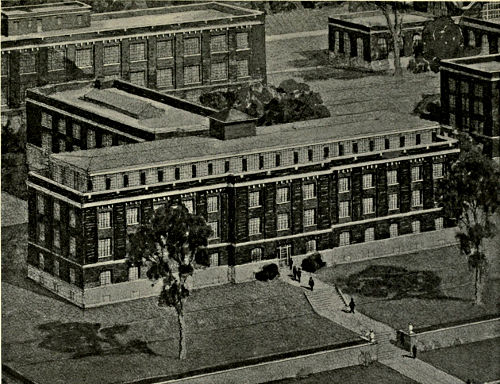
THE NEW SING SING PRISON, OSSINING, N. Y.—PSYCHIATRIC BUILDING
Lewis F. Pilcher, New York State Architect
[Pg 18]The results of Dr. Glueck’s studies have been published in full in “Mental Hygiene” and elsewhere, and form a valuable foundation for the scientific handling of the mental side of prisoners.
The commission and the state were fortunate in having Mr. Pilcher, the New York State Architect, to translate these ideals into actual construction, and the completion of an important part of the plans, including the Clinic Building, and, most of all, the final assigning of the contract for the erection, insured the carrying out of this interesting and important project.
Mr. Pilcher has thrown himself into the undertaking with singular diligence and intelligence, and has entered thoroughly into the spirit of modern scientific treatment and research.
The newest and most original feature of the prison is the Clinic Building, in which the study and classification of the prisoners is to take place, and in which, as well, the general medical and surgical work of the institution will be carried on. It provides for the complete physical and mental examination of every inmate. It contains the hospital wards, dispensary, operating rooms and laboratories and X-ray plant, and indeed, it corresponds on a small scale to the hospital of any community, but differs from this in that it assumes that the whole population of the community may be abnormal, and therefore requires that every member of it shall at some time pass through the clinic for purposes of study and analysis. For this reason, the psychiatric or mental division of the clinic is relatively more accentuated.
It requires courage to attack such a problem as this, an attack that may carry us into troublesome social fields. It seems to be a fact, however, that no other method gives promise of relieving society of any considerable part of this burden of suffering and cost. We must not expect ever to be entirely rid of this burden, just as we shall never be rid of the burden of physical and mental disease; but just as science has diminished and is still diminishing these latter, so we have reason to believe that similar scientific methods, properly applied, will diminish the burden of anti-social behavior, and help us to approach the irreducible minimum, a minimum which must probably always exist in a human world like ours, but a minimum from which we are at present still very far.
By Lewis F. Pilcher, New York State Architect
(Reprinted by permission from the American Architect of January 28, 1920)
Commercial efficiency is determined by the use of the by-products of manufacture. Prisoners are by-products of society.
The modern enterprise that used to discard as waste the by-products of its plant now aims to reduce its overhead and better its system by returning to the community in usable form that which in past times had been considered as lost and unavailable material. Is it not true that the criminal has been for the most part considered in the past as an irreclaimable waste of society, his progress toward a better life inhibited by being held in the strait-jacket of strictly materialistic institutional management and maintenance? As in the case of manufacturing concerns so in the modern penal system, its success will be determined by the economic use, and measured, not by the development of model prisoners enchained securely behind bastioned walls, but by returning to society decent citizens.
In the past the achievement of positive human results has been seemingly impossible to obtain. The chief reason for this failure was due to the inevitable clash between institutional and political interests that always arose and rendered abortive the many attempts that have been made to treat successfully the complex questions of crime and punishment.
Any betterment procedure must be in the direction of individualization. The modern prison, penitentiary, jail or reformatory should embody in their respective organizations the function of scientific study of the individual prisoner—and this should be made the fundamental element of the entire correctional process.
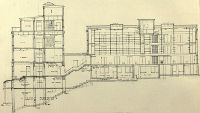
OUTSIDE CELL BUILDING—NORTH ELEVATION
The side elevations show the terracing of the site and the advantages derived from the differences in levels
The dynamic unit of all human problems is the individual. Modern medical science makes the appraisal of this unit possible through the medium of psychiatric treatment and social service research. An undertaking, however, which is really consciously intent on reclaiming the individual prisoner to the limit of his capacity with a view of preventing future returning to misbehavior, would be hampered in its effect if it were to concern itself solely with the native endowments of the individual prisoner. The source of the prisoner’s particular being, life, is a dynamic process; and every contact the individual makes throughout life not only leaves its impression on him, but shapes his mental attitude toward his environment. Thus, it is obvious that the housing problem, touching as it does every phase of the life of man, is of fundamental importance, for the environment determines, through the influence of the associative imagery of the inmate, a control of his conscious acts and the mechanization of the conscious acts of the prisoner establishes his habits. The manner in which the prisoner has been handled in the past has unquestionably been responsible, if not for the great amount of criminal careers, certainly for the confirming of the individual in his life of crime. The character and kind of prison we have had, in the past, had as its sole aim to achieve mediæval security; a housing condition crude and archaic in conception, which has not helped to relieve and protect society against the spirit of crime, but on the contrary has actually tended to its increase.
Here in New York City the municipality protects the interests of its citizens by the enactment of a structural and sanitary code. Structural safety and physical security and health are provided for all classifications of human activities under the maturely established provisions of that code.
DETENTION BUILDING
Typical floor plan of Detention Building, a basement and four-story outside cell building. This plan shows the arrangement of cells against outside walls, which gives to each inmate direct sunlight and air
Scientifically, psychologically and practically important as is the structural side of this great prison problem, I have yet to see any workmanlike attempt to establish for prison planners a code so carefully developed and yet with an elasticity to adapt it to various localities and climates, to the end that the inhumanity of the present day, 1920, toward prisoners would be for all time impossible.
The tremendous security and help that such a code would provide for the development of state prisons and jails and reformatories is at once apparent.
The complete findings of a competent Code Committee would be the average of the experience of all penal housing problems throughout the country and should be determined by a two-group committee, acting under an organization of national scope. In one group should be available the experience and suggestion of the leaders in penal administration, medicinal, psychiatric, industrial, vocational, educational and religious activities. The second group should consist of a small number of architects, engineers or contractual experts—men who have actually planned and structurally executed prison buildings and whose practical experience would enable them sympathetically to translate into constructive form and crystallize the theoretical standards recommended by the sub-committee on strictly scientific phases.
As it is an admitted fact that apperception and interest are the cardinal principles of thought foundation, it may be seen that the chance of improvement in the prisoner will vary in accordance with the thought and action required of him. In order, therefore, that this idea may be efficiently carried out, the prisoner, immediately on commitment to prison, should receive the benefit of an expert clinical examination to determine through his mental and economic possibilities what branch of work he should follow during his term of imprisonment to insure a better existence and a chance to live a decent and productive life after discharge.
The new Sing Sing, therefore, has been planned as a Classification and Distributing Prison, from which the prisoner, after a definite determination has been made of his mental, physical and economic possibilities, will be assigned to that State institution best suited to his individual demands. For example, if it be found that a prisoner is physically unsound, he will be sent to an institution where he can be therapeutically bettered; or, if mentally deficient, to an institution where he can be scientifically[Pg 23] treated, and, if possible, given work that will enable him to direct his minimal capacity so as to exempt him from purely custodial care.
The construction and location of the buildings at Sing Sing mean much more, therefore, than the mere erection of a series of large prison buildings for the detention of those who have violated the laws of the State. It will exist as a twentieth century prison elixir, which will take the recrement of society and so purge and refine it that the result will advance, rather than retard, the onward and upward movement of humanity.
In order fully to understand the problem of prison registration, let us follow the course taken by the convict upon his arrival at the Sing Sing of the future: Immediately upon entering the prison grounds, the Court Officer conducts him to the arrival room in the basement of the Registration Building. Here he is turned over to the prison authorities, who take and receipt for his personal property and clothes. The civilian clothes are removed for disinfection and storage. He is then led to the baths, situated across the hall from the property room. After being thoroughly bathed, and subjected to a hasty medical inspection, clean prison clothes are provided. Then, contagion from outside sources having been removed, the prisoner is lodged in a classification cell on the first floor, to await his turn for examination in the rooms provided for that purpose on the second floor. When the examiner is ready for him, he is taken upstairs to be photographed, weighed, finger-printed and generally “Bertilloned,” and is then sent across the hall to be given a preliminary examination for the determination of his general physical condition. This over, he is led to the educational examination room, where facts concerning his birth, occupation and general history are recorded, and an examination conducted to determine both the extent of his education and his occupational skill. Following that comes a careful mental examination in which the findings of those just preceding are fully utilized. As a result of these different examinations his first classification is made, subject of course to change from examinations to be conducted later.
Besides containing the general Administration Offices, the Bureau of Registration and the Record Bureau the Registration Building will include a reception room where prisoners may converse with visiting relatives and friends. In the past this problem of a reception room for the visitors to prisoners was a difficult one for prison authorities, as it was practically impossible while allowing prisoners a reasonable amount of freedom for the discussion of private and confidential matters to prevent the transfer of weapons, liquors, drugs and implements of escape. This difficulty, however, we think, has now been successfully solved through the following arrangement: Two parts of a large room are separated by two wire nettings, so placed that they form an enclosed passage six feet in width, where guards can be stationed to prevent any attempt to pass articles to the prisoners without, at the same time, interfering in the carrying on of a conversation.
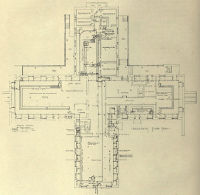
MESS HALL AND KITCHEN BUILDING—BASEMENT
This Floor Contains a Bakery with Flour and Bread Storage Rooms and with Equipment to Provide Bread for the Entire Institution, Refrigerating Rooms for the Storage of Unprepared Food, a Plant for the Making of Ice, and an Ample Kitchen Store Room.
A Mess Hall with Independent Coat Room and Outside Entrance, a Guard’s Toilet, Recreation and Lunch Room are also Provided.
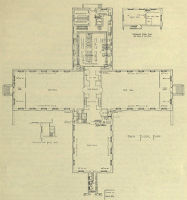
MESS HALL AND KITCHEN BUILDING—FIRST FLOOR
This Building Occupies the Central Position of This Group and is Easily Accessible from all Cell Buildings.
The Mess Halls are so Designed as to Take Complete Care of the Inmates of One and Two Cell Buildings in Each Hall Respectively.
The Inmates of the Detention Building Can Enter Their Mess Hall Directly from the Detention Building by the Enclosed Passage.
A Kitchen Economically and Efficiently Equipped Occupies the East Wing of This Building.
Adjacent to the Registration Building, and on the same high plateau overlooking the Hudson, is the Temporary Detention Building, with cell rooms on separate floors, so arranged as to place the prisoners under the constant supervision of the clinical experts, who will conduct their examinations in the adjoining Clinic Building.
The clinical laboratory was developed under a medical commission composed of: Dr. Walter B. James, President of the New York Academy of Medicine; Dr. Charles W. Pilgrim, Chairman, New York State Hospital Commission; Dr. Thomas W. Salmon, Director of the National Committee for Mental Hygiene; Dr. G. H. Kirby, Director of the Psychiatric Institute of the State of New York; Dr. Isham G. Harris, Superintendent of the Brooklyn State Hospital; Dr. Carlos F. MacDonald, Alienist, and Dr. W. F. Brewer, Surgeon. Provision has been made on the first floor for a modern X-ray apparatus and its various accessories; three rooms for the physician in charge of the venereal examinations; a surgical laboratory; rooms fitted for the examinations of the eye, ear and throat, psychiatric and psychological examining room, dental operating room and laboratory, and a laboratory for the use of the staff working in the diagnosis and examination rooms.
On the second floor is a quantitative and qualitative laboratory; a museum, a recording room, a library and lecture rooms, and on the third floor are surgical wards, subdivided for major and minor operative cases, together with medical wards, so planned as to have ordinary and chronic medical cases in separate divisions. The hospital is to be freely used for detailed observation as well as for treatment.
The fourth floor contains a complete operating department with two operating rooms, one for major and the other for minor operations, each having separate sterilization facilities, together with preparation, etherizing and recovery rooms, while the remainder of the floor is given up to rooms for the male nurses and a convalescent solarium.
In addition to using the building as a clinical hospital for the housing of psychiatric and medical requirements of the prison, it is also planned to use it as a school for the education of male nurses, as it is found that efficiency in prison nursing is directly proportional to the nurse’s understanding of the relation of scientific, medical and psychiatric knowledge to the peculiar problems of a prison community.
The entire Sing Sing project includes kitchens, dining rooms, library, school, vocational shops, recreation hall, roads, walks, a modern sewage plant, a power house to heat and light the many buildings and to operate the industrial plants, and a church for the development of religious and community ideals.
In addition to the proper placing and co-ordination of the structures and their component parts, and the abolishment of unsanitary conditions in the interiors, by the architectural treatment of buildings and site, a great step forward has been taken in the creating of a proper and fitting atmosphere and environment. The old idea of the ugly, heavy barred and broken walls, which produced the dismal, forsaken, isolated and jail-like appearance of former prisons, has been discarded. In their places will be many-windowed, substantial brick structures, extending from the river to the plateau in the rear of the elevated site, in dignified and well-proportioned stages.
The causes which formerly created in prisoners the feeling of being entombed, useless and hopeless exiles have been done away with. It is our hope that ideals of respectability, industry, efficiency and co-operation will arise from these new prison conditions and make strong, beneficial and lasting impressions on the mind of each prisoner.
It is only by such utilization of the experiences in allied fields and their thoughtful application to prison conditions that progress may be hoped for in solving this important human problem.
By Lewis F. Pilcher, New York State Architect
(Reprinted by permission from the American Architect of January 28, 1920)
The more advanced of the modern penologists are rapidly discarding the old theory that a certain humanity and kindliness should be eliminated from society’s dealings with its less responsible citizens. They are substituting in its place the idea that the majority of criminals are not inherently bad, but, lacking the idealistic principles of good citizenship which result from environment and education, are only wayward.
If we accept this new theory, and make negligible the assumption that most criminals have inherited a tendency toward wrong-doing, it becomes necessary for us to revise many of our ideas concerning the government, discipline and housing of prisoners, and to acquire an impressionable quality of mind susceptible to new theories and experiments which concern the welfare and advancement of our less fortunate fellow men.
With all these things in mind, and with the desire to do our part in ameliorating prison government, the Commission on New Prisons has endeavored, in the building of the Wingdale Prison, to achieve a good architectural result combined with these essential reforms. In order that these aims may be fully understood, I shall attempt to explain both the architectural plan of this new prison and the reasons for selecting a sloping rather than a level topographical site.
If one surveys the history of civilization and investigates the growth and final results of the structural plan of either religious or civil communities, it is at once apparent that the final housing scheme of any given settlement is determined by the topography of the region of its location.
For example, the study of the settlements of antiquity shows that the higher locations were universally chosen as the sites of palaces and temples, and that where the configuration of land did not permit of such natural elevation, mounds or raised crepidomas were constructed, in order that by means of the terraced elevations a distinction might be made between the different degrees of religious prominence.
That the Egyptians who inhabited the level areas of the alluvial Nile appreciated the psychological effect of such terraced elevation is shown by the architectural arrangement of their temples. To emphasize the hieratic mysteries, the worshiper was led from a pyloned gateway into an atrium with a pavement slightly graded above the level of the dromos. This atrium, open as it was to the effects of the brilliant Egyptian atmosphere, offered a subtle psychic preparation for that elation of soul which stimulated the novitiate when, after ascending the steps on the far side of the atrium, he entered the sombre shadow of the hypostyle hall. This elation increased in many cases to a religious ecstasy when the novitiate ascended into the upper region where the esoteric mysteries were performed.
A simpler expression of this religious constructive arrangement may be seen in the Temple of Kohn. Here the priestcraft developed a form of temple construction which crystallized all the associative imagery of man and reflected in its different stages of elevation of the various sections the relevant distinctions of class and the progress of humanity toward its idealistic goal.
Thus in the low grade level of the atrium the light, the air, and freedom of movement suggested that lack of function and freedom from formal life which exists among the multitudes; the conscious effort of ascent in walking from the atrium to the hypostyle hall suggested the difficulties of rising from a lower to a higher social order, while the further ascent to the small, calm and dimly illuminated holy-of-holies symbolized the fact that only through struggle, loneliness and pain may a devout one hope to attain the quiet and sublime dwelling place of the gods.
When the Greeks rose to intellectual and artistic position they evolved the Greek form of temple, which was simply an Hellenic translation, through the medium of the Mosaic temple, of the Egyptian hieratic imagery. Perhaps the most typical of these temples is the great marble Parthenon (438 B. C.) which was reared upon a three-stepped crepidoma, a worthy stylobate support, a marvelous peristyle, reminiscent of the open air atrium of its Egyptian prototype. Further on, and beyond the peripteros, and at a higher level, the pronaos led through a great door into the shrine chamber of Athena. Thus did the architects, Ictinus and Callicrates, express in much the same manner as the Egyptians the essence of crystallized human experience.
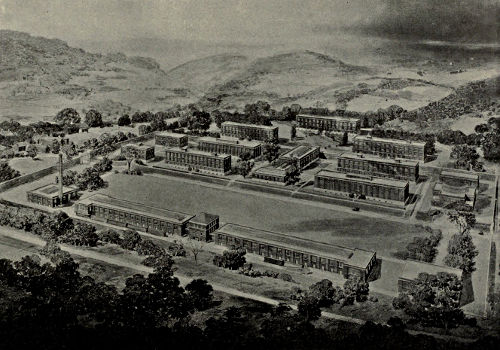
GENERAL VIEW, WINGDALE PRISON, WINGDALE, N. Y.
Lewis F. Pilcher, New York State Architect
In the flat country of Mesopotamia the architects built lofty zekkurats in order to provide high substructures for the crowning cella or shrine, and these lofty, temple-capped pyramids had a materialistic as well as a spiritual value in that they helped to form in the minds of the people an ideal as to the position in the community of both temporal and spiritual power.
To the north, at Khorsabad, a city of Assyria, the rulers constructed, as part of the great wall, an enormous plateau. This artificial mound, towering as it did some sixty feet above the level of the city, was used as a place of residence for the king and his court, while back of it, and so high that it bathed the plateau with its shadows, was constructed the many-stepped, cella-crowned temple of the priests. Thus religion looked down upon royalty and royalty, in turn, on its walled city with its level streets and multitudinous inhabitants, and thus in this segregated and self-sufficient community a natural and unwitting psychological arrangement of class housing was worked out by these early architects.
This same community phenomenon which we have noted in the Orient existed at the same time at Mycenae, Thyrns, Argos, Attica and Rome,—the heights being always occupied by the rulers, the foot-hills by the nobles and the adjacent plains by the people.
By these few examples taken from the religious and civil architecture of early civilization I have endeavored to show that class distinction tends to express itself through the use of different housing levels, the height of each group being directly proportional to the power of its social division, thus giving a concrete expression to the theoretical grades by which the human mind differentiates the social status of the people who comprise any given group.
If we apply this rather pragmatic psychology to the problem of planning a new prison, we find it obvious at the outset that a prison population forms, together with its dependencies, a complete segregated community and therefore presents few phases which have not been successfully solved in the various treatments of community houses in past eras. Bearing in mind both this and the psychological principles which determine the function of any segregated community, it becomes perfectly clear that the old system of plotting an entire prison plan on an absolutely level piece of ground does not agree with either the teachings of history or the psychological principles which determine the site of community housing, and it thus becomes manifest that if we are to plan a prison which will be both a protection and a benefit to society we must select our site and construct our plans with the idea of having different grades of elevation for different degrees of social eminence.
If, remembering this, we summon practical experience to our aid we find that a prison population divides itself naturally into three major divisions, two of which are composed of actual inmates and a third of those in authority over them. The first and largest of these groups is made up of sub-normals and general recalcitrants who of necessity must work, eat, and sleep under constant and direct supervision. These will be confined in strong, well-guarded buildings situated within a walled enclosure and the work which they do will be such as can be efficiently done within the comparatively small space to which they are restricted.
The second group, composed of prisoners who have shown themselves worthy of trust, will be allowed privileges which are denied the first. A concrete expression of these privileges will consist of lodging them in buildings situated on a higher level and with no enclosing walls, thus allowing them to carry on dairying, farming, stone crushing and similar industries.
As the working out of our community idea demands that the governing class occupy a higher site than those they govern, we have planned an adjacent but higher elevation for the offices, dwellings and other buildings necessary for the proper maintenance of a model prison.
In our plan for the new Wingdale Prison we have attempted to express a prison which will meet the scientific and historic precedents which we have at our command, and we fully believe that our plan will exert as beneficial an influence on our prisoners as did the noble monuments on the Acropolis at Athens on the humble people who constructed their mud-brick houses at its base.
By Hastings H. Hart, LL.D.
Alabama was the last of the Southern States to retain the convict lease system. The system has been very profitable, having produced for several years past more than $1,000,000 per year of net revenue.
The last legislature decreed the abandonment of the convict lease system in January, 1924, and in preparation for this change the State has undertaken the construction of the most elaborate prison in the south, with the possible exception of the United States Prison in Atlanta.
Under the laws of the State the prison managers have authority to expend the revenues from convict labor for land and improvements. Acting under this authority, Gov. Thomas E. Kilby; Hon. C. B. Rogers, President of the State Board of Control; and Dr. William F. Feagin, Warden General of the penitentiary system, have united in the effort to perfect a model southern prison.
The general plan of this prison was suggested by the Minnesota State Prison, with the important change, however, of adopting the outside cell system instead of the interior cage system. The adoption of the outside cell plan of construction increases the opportunity for escapes; therefore the prison wall surrounds the entire prison. None of the buildings except the office building is on the outer wall.
Following the example of the United States Government prison at Atlanta, the cells above the first tier are constructed to accommodate five prisoners each. The lower cells for one man each are of generous capacity, 7 feet wide, 10 feet long, and 8½ feet high, with an outside window for every cell, and elaborate ventilation system.
Alabama has about 3,000 prisoners. The new prison is designed to accommodate 800 men, with plans for enlargement to double that capacity. The remainder of the State convicts will probably be kept, as heretofore, in prison camps and employed on State farms. It is probable that the prison at Speigner, with the State cotton mill, will be continued, at least for the present.

FRONT ELEVATION
The employment of prisoners in the cotton-mill industry has been successfully tested at Speigner, and it is purposed to establish a new cotton mill at Kilby Prison which will employ the greater part of[Pg 31] the prisoners. It is proposed to manufacture cotton cloth suitable for shirting and to establish a shirt factory where the cloth will be manufactured into shirts for the market. The manufacturing will be on State account, the shirts to be sold at a contract price agreed upon in advance under certain standards of quality.
A large farm is attached to the prison where a model dairy has already been constructed with a herd of 90 Guernsey cows and an extensive piggery.
It is expected that this new departure will bring Alabama from the rear of the procession in prison administration to the front rank.
By Martin J. Lide, Engineer and Architect
Kilby Prison is designed essentially as an industrial prison. There are about 3,000 State convicts in Alabama. The labor of the majority of these heretofore has been leased out, principally to mining and lumber corporations. The State is poor in revenue and backward in education. It is, therefore, essential that these convicts be put to productive work in order that they may be at least self-sustaining. By act of the Legislature the leasing of convicts must cease after January, 1924. In order to receive these convicts from the mines and lumber camps and to place them into productive work this prison is being constructed.
As will be noted from the ground plan, the prison, exclusive of the administration building, is contained within a surrounding walled enclosure. The wall is about 20 feet high, 12 inches thick at the top, and 20 inches thick at the bottom, and sits on a concrete mat 6 feet wide. At the four corners of the wall are concrete guard towers, and on one side there is a lock gate 120 feet long, equipped with steel doors suspended with rollers. The walls are 1,000 feet long at the front and are 1,200 feet long on the sides. The wall is constructed in sections 30 feet long. Expansion is taken care of by the construction joints. During cool weather these joints were painted with tar, the thickness of the coating depending on the temperature at the time of the pouring. The concrete aggregate was mixed in the proportion of 1: 2: 4 parts of cement, sand, and gravel, the sand and gravel being mined on the property by the State. At the top of the wall four strands of barbed wire are mounted, alternate strands being charged to a potential of 6,600 volts, and the other strands being grounded. The connections to these strands are such that in case the charged wire is either cut or short circuited, an electric siren will blow.
It will be noted from the ground plan that the administration building is in front of the prison on the outside of the walls. Thus all free office employees work outside the prison. The administration building is a one-story building of brick and concrete. Connecting the Administration Building with the cell house is a corridor flanked on either side by rooms whose purposes are set forth in the ground plan drawing.
The main cell house is a monolithic concrete structure veneered with brick and with cement tile roof laid on steel purlins. All cells and walkways are of concrete. The cell house contains five tiers of cells, the first tier being composed of single man cells and the remaining four tiers of five or six man cells. The single man cells are 7 feet wide, 8½ feet high, and 10 feet deep, and the multiple man cells are of the same height and depth, but are 22 feet wide. The rows of cells are separated by a 15-foot corridor with an open well in the center and with 3 feet 6 inches walkways in front. Every cell has one or more windows which are screened, barred with tool-proof steel guards, and equipped with counterbalanced steel sash. The cell building is so constructed that the multiple man cells may be converted into single man cells at any time in the future. Toilets and lavatories are provided for each cell. Forty-eight-inch roof ventilators are mounted on the cell house at 15-foot intervals. These ventilators also have fans mounted in them, the fans being driven by a common line shaft from a motor in the attic. By means of these fans it will be possible to completely ventilate the cell house at intervals, the air being drawn in from the windows and discharged from the roof.
As will be noted from the plans, large day-rooms or school-rooms separate the two wings of the cell house. These rooms are located on the second and third floors. These rooms will be used for religious purposes, as school-rooms, and for rest-rooms during rainy Sundays and holidays. In the rear of the cell house is a corridor flanked on either side by rooms whose purposes are explained on the ground plan. The corridor connects with a concrete and steel building in the rear, one wing of which will be used as a detention cell house and punitive cell house and the other wing as a utility house.
The detention cell house is two tiers high and contains 60 single man cells, each 6 by 10 feet, and 8½ feet high. These cells are otherwise similar to the single man cells in the main cell house. As may be inferred from the designation, the detention cell house will be used as a clearing-house for all new State convicts. All new convicts will be sent here for a quarantine period of ten days to two weeks. During this period the new convict will be given a careful mental, moral, and physical examination, and his past history will also be investigated. Obviously, the purpose will be to protect the prison body from the infectious diseases brought in by new convicts, to correct physical defects in the new prisoner, to make the necessary identification records, and to study the mental and physical characteristics of the prisoner, in addition to his past history, in order that he may be properly classified. By this means the mental and physical degenerates, confirmed criminals, and diseased criminals may be isolated from their fellows by placing them in the single man cells. It will also be possible, by proper classification, to segregate convicts of the same social and moral strata into the same multiple man cells.
At the outer end of the detention cell building is the punitive cell building, containing 24 concrete cells supplied with mechanical ventilation. Twelve of these cells will face the windows and will thus be solitary light cells, while the remaining 12 cells will face the dark corridor and will thus be solitary dark cells. In future, confinement and other methods of punishment will supersede corporal punishment in Alabama prisons.
On the opposite wing from the detention cell house is a utility building which is a brick and steel building containing clothing storage rooms, laundry, shower-bath, clothing and shoe repair room, and locker room for the clothes.
A concrete and brick corridor, 10 feet wide, connects the detention cell house with the kitchen and mess hall in the rear. Space is provided between these two buildings for the future construction of another cell house which will double the cell facilities.
The mess hall and kitchen consists of an open brick and steel building, with brick walls, steel trusses, cement tile roof, no ceiling, and with concrete floor. The building is approximately 65 feet wide and 225 feet long. Forty-eight-inch ventilators are mounted between each pair of trusses. Steel factory sash with large ventilators are used throughout. All windows are barred and screened. The mess hall will also be used temporarily as an auditorium for speakers and picture shows. On the opposite wing from the mess hall is the kitchen, which will be equipped with steam cooking equipment. In the rear of the kitchen is the cold storage plant, consisting of vegetable, meat and ice storage rooms, and a complete refrigerating plant. In the rear of the mess hall is a covered concrete walk connecting same with the power plant. This walk is of permanent construction, with cement tile roof. The essential purpose of the shed covering the walk is to protect prisoners from the rain in going to and from the factories in the rear of the prison yard.
The power plant is located at the end of the covered walk. It consists of a brick and steel building with cement tile roof and concrete floors. The boiler plant consists of three 200 H.P. boilers connected to a radial brick stack 6 feet 6 inches in diameter by 150 feet high. In front of the boilers is a concrete bin underneath the railroad tracks, which are on the yard grade. The power plant contains a 100 K.W. emergency lighting generator, switchboard, vacuum pumps, feed water pumps, heater, and piping. All buildings are supplied from the power plant with vacuum steam heat, hot water, and electricity through a system of tunnels which connect the power plant with all buildings. Hot water is also supplied to the several buildings from a large heater located in the laundry room.
To the left of the prison proper is located the hospital, as indicated on the ground plan. This building is of brick and concrete, with cement tile roof. In general, as indicated, the hospital consists of a central administrative and operative portion, connected to wings at either end by means of corridors which are also flanked by rooms. Racial segregation will take place by placing white and colored patients at opposite ends of the hospital. At each end of the hospital are provided surgical and medical wards, each connecting into a sun-room.
By the construction of an additional cell house in the space indicated by the dotted lines on the ground plan, and by the construction of an additional kitchen and mess hall between the present mess hall and the power house, the population of the prison may be doubled. The present prison is designed to accommodate 800 prisoners on a basis of five men to the large cells. By putting six men in the cells, however, the present population may be increased to something over 900. By constructing an additional mess hall and kitchen, racial segregation may be more completely effected.
The present capacity of the hospital is 32 patients, but this capacity may be increased by extending the surgical and medical wards.
At the rear of the prison a cotton mill and a shirt factory are being constructed to consume the labor of the present prison population.
The dominant consideration in the construction of the present prison has been the question of the maximum possible economy in first cost consistent with permanency and the security and welfare of the prisoners. All buildings are practically fireproof, but are no larger than are absolutely essential, and as far as possible all non-essential features have been eliminated. All essential utilities, such as a complete telephone system, alarm signal system, steam heat, an adequate lighting system for both the interior and the exterior of the prison, hot and cold water, etc., have been provided.
Economy in first cost was the guiding consideration in the construction of the cell houses, although a monolithic concrete structure with brick veneered exterior walls is by no means a cheap construction. But it is a permanent and safe construction. Economy in the construction of the cell house was secured through its compactness.
The outside type of cell house can be made practically secure for all classes of prisoners when surrounded by an outside wall of adequate height, with its top guarded by high tension charged wires, provided the windows to the cell houses are barred with steel-proof window guards and the prisoners are reasonably well guarded.
The relative hygienic and physiologic advantages of the outside and inside cell construction I will not discuss here except to say that we considered the outside cell construction manifestly superior in both of these respects. While we consider these features very important in a permanent prison, the question of economy in initial cost was also important in that the outside cell type of prison is a considerably narrower prison for the same cell capacity, and, furthermore, since continuous mechanical ventilation is not essential with the outside cell type, it can be[Pg 37] more densely occupied, which further promotes economy in construction.
In designing the outside cell type of prison the problem is one of providing a certain definite external wall area for the sides of the prison, since for given dimensions of cells and a specified number of these cells a definite external wall area is required. The problem of maximum economy in construction then resolves itself into a question of providing the maximum of wall area with the minimum of floor area. Two general forms of outside cell buildings have been proposed: one, the narrow rectangular type adopted at the Kilby prison, and the other the cylindric type. It is demonstrated in geometry that of all figures a circle has a maximum of area for a given length of periphery, while a very narrow rectangle or quadrilateral has a minimum of area for a given periphery. It is, therefore, obvious that for a given external wall area, or a given cell capacity, the narrow rectangular type is more economical in first cost, since it reduces the ceiling and floor area to a minimum.
Economy in construction was also promoted by constructing our cell house five tiers high instead of four tiers, as is more usual.
Finally, additional economy was secured by the use of the multiple man cell. Our multiple man cells accommodate six prisoners, while three single man cells of the same cubic contents containing two partitions, two extra prison doors and locks, two extra lavatories, two extra water-closets, two extra radiators, with all of the necessary connections to these utilities, will only accommodate half as many prisoners. It will, therefore, cost more than twice as much in cell-house construction to incarcerate a given number of prisoners in the single man cells than in the six man cells.
It will, therefore, be noted that we have secured economy in cell-house construction (which is the most expensive item of prison construction) by increasing the density of occupancy in the cell houses. But this density of occupancy carries with it responsibilities in the matter of providing adequate ventilation for the inmates. Recognizing this responsibility, we have designed our cell house to secure the very maximum of natural ventilation. This is secured, first of all, by a very large proportion of window area to wall area; by ventilating the windows top and bottom; by constructing the cell house with a cross-section shaped like a chimney, with a large number of large ventilators on top of an open pitched roof, so as to secure the very maximum of chimney effect and also the very maximum effect from breezes.
Finally, to insure an adequate supply of ventilation in the summer, when there may be neither wind nor temperature difference, we have mounted disc fans in each ventilator, driven by ball-bearing shafting from a push-button-controlled motor. By this means the cell attendants, by pushing a button, will be enabled to flood the cell house with fresh air at any time the air becomes foul, and since the attendants will be on the inside of the prison, where the air will be most foul, they will probably make use of their opportunities.
Apart from humanitarian considerations, which in a large measure should dominate the designer of a prison, there is also the economic question of securing the maximum mental and physical output from the prisoner while at work. In an industrial prison a man can do more and better work if he sleeps and rests sufficiently. If the cotton mills are to be operated double shift during summer months with a large portion of the population sleeping during hot summer days, it is doubly important that the prisoners be confined in well-ventilated and sanitary quarters. This fact we have borne in mind in the design of the cell houses at Kilby Prison.
By Hastings H. Hart, LL.D.
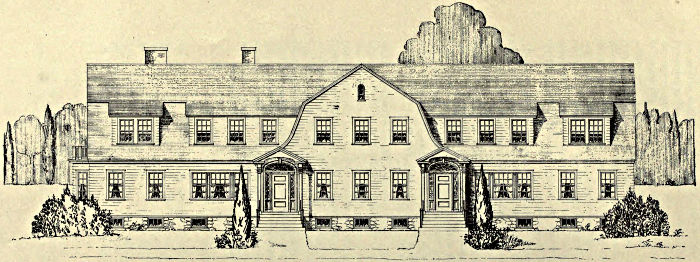
PERSPECTIVE OF RECEPTION BUILDING, CONNECTICUT STATE FARM FOR WOMEN, Niantic, Conn.
Several States are developing prison farms for women on the cottage plan. We present herewith plans of two cottages recently constructed at the Connecticut State Farm for Women at Niantic and the New Jersey Reformatory for Women at Clinton.
State reformatory institutions for women are rapidly being developed in the United States. The first two institutions of this class, the Indiana State Reformatory for Women at Indianapolis and the Massachusetts Reformatory for Women at Framingham, were prison structures, less rigid and formal than typical prisons for men, but still following prison models.
In the meantime the cottage system for younger girls grew up, and it was soon found that delinquent girls could be safely kept in ordinary cottages without any surrounding wall and without prison construction.
When the New York State Reformatory for Women was built at Bedford, cottages were erected instead of a large congregate building, and the gates of the institution stood open day and night. While occasionally escapes took place, the number was not large, and the fugitives were usually speedily recaptured.
All the new institutions for delinquent women are on the cottage plan, and in most cases the cottages are of simple construction, without window gratings, strong bars, walls, or even fences. In some cottages an iron grill protects the lower sash; sometimes this grill is masked by window plants.
The Connecticut State Farm for Women receives women committed for misdemeanors from all parts of Connecticut. There are only eight women convicted of felonies in the Connecticut State Prison at Wethersfield, but a considerable number of women are still committed to the county jails throughout the State. All the women at Niantic are committed for criminal offenses.
Three old farmhouses have been refitted to serve as cottages, and one new Reception Building has been erected to accommodate 27 incoming women. This is a wooden building, similar in construction to a well-built farmhouse. On the first floor are a kitchen, a dining-room, a living-room, and a reception department for incoming prisoners, with hospital[Pg 39] wards, isolation wards, and accommodations for officers.
The dining-room and living-room are practically one room, so that the dining-room with its tables is available as an evening sitting-room and living-room.
On the second floor are single rooms for inmates, with accommodations for the matron and her assistant. The rooms are about 7 by 10 feet. They are simply but neatly furnished. Notwithstanding the fact that this cottage is designed for the incoming prisoners who are most likely to run away, the doors of this house are unlocked throughout the day.
The farm contains about 500 acres. Three old[Pg 40] farmhouses, having been repaired and supplied with plumbing, furnish houseroom for three groups of women, each under charge of a matron. No one of these buildings is in any sense “secure”; but escapes are infrequent, and escaping prisoners are usually recaptured.
The only secure place on the farm consists of three small “thinking rooms” located in the basement of the receiving cottage. These rooms have strong doors and barred windows. Their construction is not satisfactory, but they will be replaced by more suitable detention rooms when additional buildings are erected.
The present buildings are inconvenient and ill[Pg 41] adapted to the care and supervision of the women. When permanent buildings are erected, the work of the officers will be greatly simplified; but the probability is that the new buildings will be of simple construction, similar to that of the buildings that have already been erected.
The small number of escapes from the Connecticut State Farm for Women and Clinton Farms in New Jersey appears to be due to the establishment of a certain morale among the women. This morale rests partly on the fine spirit of the superintendents and their staffs, partly upon the certainty of recapture, and partly upon the spirit of the inmates. Running away is contrary to the practice of the place. “It isn’t done.”
Newcomers have to be carefully watched for the first few days until they overcome homesickness and become won to the place. After that they are less likely to attempt to abscond.
We present herewith the plan of the maternity cottage of the New Jersey State Reformatory for Women. This cottage is designed for the reception, care, and treatment of young mothers and babies. The building is 102 feet long and 40 feet wide, with a rear extension 24 by 28, containing the kitchen on the first floor and bedrooms for inmates on the second floor. The whole aspect of the house is cheerful and there is no appearance of a prison about the place.
The building contains 20 sleeping rooms for inmates, with a sleeping porch having room for ten additional inmates, and having a separate dressing-room for each person. There is a nursery for 12 or 14 infants, with a large sleeping porch.
The building is so arranged on both floors as to minimize the amount of waste space. There is a corridor on each floor which is only 60 feet long and 6 feet wide. This corridor terminates at each end in a large room so as to avoid unnecessary corridor space. The rooms for the inmates are about 6½ by 10 feet. Each room has a good outside window.
In this cottage kitchen space adequate for preparing of mothers’ and infants’ food is provided. A diet kitchen adjoining the larger kitchen assists in the preparation of the infants’ food. A dumbwaiter shaft extends from this diet kitchen to the second floor, where a small diet kitchen for food service and storage of milk formulas is provided. In this diet kitchen is a refrigerator especially adapted to the needs. This refrigerator is six feet high and six feet wide, porcelain lined, with shelving specially planned to hold wire baskets containing the regular eight ounce nursing bottle. No other foods except the milk formulas are kept in this refrigerator.
Room is provided in the basement for milk pasteurizer with 144 bottle capacity. This is connected with high pressure steam.
Adjoining the nursery is a specially equipped infants’ bath-room. A small bath-tub and two bath-slabs provide ample bathing facilities for both small infants and those of larger size. Tiled floors and hard finished walls make this a most sanitary arrangement.

CAROLINE BAYARD WITTPENN MATERNITY COTTAGE, STATE REFORMATORY FOR WOMEN, CLINTON, NEW JERSEY—SOUTH ELEVATION
Francis H. Bent, Architect
This building is constructed entirely of hollow tile and stucco corridors of cement, and rear stair and front stair fireproof towers of metal, and fire[Pg 43] glass construction with cement stairways. The room floors and nursery floor, living room floor, and dining room are of hardwood construction, but you will note that all exits and main corridors are fireproof.
General plan of using gray slate roof on our institution buildings has been adopted. Dormer windows in the roof give ample storage space in the attic for clothing and other stock. The laundry is situated in the basement, and here the mothers are taught properly to care for their infants’ clothing.
The other cottages are similar to those which are built for younger delinquent girls in State industrial schools, without prison construction, strong doors, or window-bars, except that in some cottages the lower window-sash is protected by an iron grill which obstructs but does not prevent egress. Some of the cottages are old farmhouses which have been repaired and equipped with plumbing in order to adapt them to their present use.
It must be borne[Pg 44] in mind that all the women in this institution are committed for criminal offenses, including many petty offenses and sex offenses. They include also such crimes as grand larceny, burglary, assault with intent to kill, atrocious assault and battery, highway robbery, and manslaughter.
There are no walls or high fences surrounding the buildings.
Notwithstanding the absence of prison walls and prison buildings, the number of escapes is very small and escaping prisoners are usually recovered within a few hours.
The institution was opened January 8, 1912, and it has received 584 women. Of these, 33 have escaped, of whom 25 have been recaptured and 8 still remain at large. This makes a record of only one and one-third per cent of successful escapes, which in view of the absence of prison restraints is a remarkable record. It certainly justifies the policy of the Board of Managers in adopting the cottage plan and discarding prison walls.
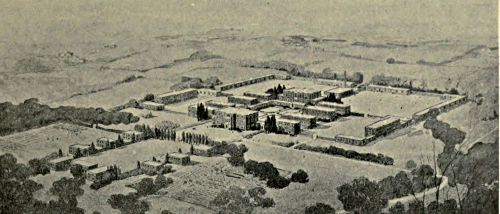
PROPOSED STATE PRISON
Alfred Hopkins, Architect
In 1915 Mr. Alfred Hopkins, architect of the Westchester County Penitentiary, drew tentative plans of a large state prison for the New York Prison Association. These plans were drawn in consultation with the late Dr. Orlando F. Lewis, Secretary of the Association. Mr. Hopkins describes the plans as follows:
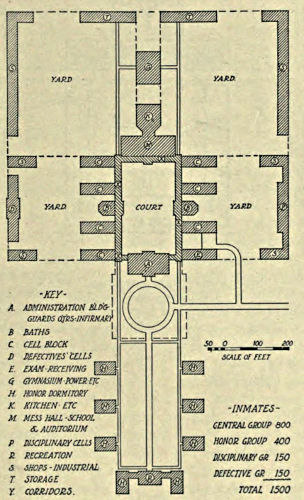
PROPOSED STATE PRISON—PLAN
It was proposed to house 1500 inmates, all told. These were divided into four general classifications: the main or institutional group was to contain 800 inmates, a disciplinary group was to house 150 inmates, a defective or abnormal group was to contain 150 inmates, and the honor group in cottages was to house 400. By looking at the accompanying plan it will be seen that the institutional group is composed of eight cell blocks of 100 men each, four cell blocks disposed on either side of the main court and all joined by a connecting corridor, establishing two general classifications which are consistently maintained throughout every function of the institution.
The cell blocks are three stories high, each floor separated and segregated from the other floors, which makes 24 classifications—all that will ever be required. There are two bath-houses, one for each group of four-cell blocks.
The administration building is placed at one end of the court and the mess hall at the other. The mess hall is arranged with entrances at each end so that the two general classifications can be kept separate in the dining room as well as in the school-rooms on the floor above. On the third floor is the large auditorium. This has been set back at the ends so as to let into the main court the maximum amount of air and sunshine.
To the right of the institution are the cell blocks and shops for the hardened offenders who will be confined here and will not leave their quarters. On the corresponding side to the left is the hospital and the quarters for the abnormal and defectives. The power house, over which is a gymnasium, is located behind the institution. The shops have been placed so that they form a large enclosure, giving two athletic[Pg 46] fields with the gymnasium between and used jointly for both, so that the two general classifications of the institution group each have their special fields for exercise. In front of the institutions is the cottage group, whose inmates will work largely in the fields. The cottages are all in smaller units where the men may be housed in dormitories or in single rooms.
Alfred Hopkins, Architect
This tentative plan was developed by Mr. Alfred Hopkins, Architect, along lines suggested by Superintendent Frank Moore, of the New Jersey State Reformatory at Rahway. It provides for three general classifications: An Administration and Custodial Group, an Agricultural Group and an Industrial Group; the various departments of the institution being connected by a covered passageway. Mr. Hopkins remarks: “While this plan is only in the nature of a preliminary sketch, it is interesting in showing that a practical prison man is quite willing to get away from the old idea of supervision which established the radiating plan and the long type of cell block.”
By Alfred Hopkins, Architect
(First published in February, 1918)

WESTCHESTER COUNTY, N. Y., PENITENTIARY—GENERAL VIEW FROM APPROACH
Alfred Hopkins, Architect
The Westchester County Penitentiary is a simple form of the type of a plan whose various parts are brought together by the use of the connecting corridor to provide indoor circulation throughout the group. This system of design is well known in connection with other types of building, but seems to be new to prison architecture. Indeed, such an arrangement would have only been tolerated in the present attitude toward the offender. Modern penology demands, first of all, adequate possibilities for segregation and classification. These are of vital importance in the administration of the modern penal institution, and cannot be properly had in the huge cell block. To achieve this classification and segregation, the connecting corridor offers the greatest possibilities.
The general problem was as follows:
Westchester County had purchased at East View, at a very reasonable price, a fine estate of some four hundred acres of exceptionally tillable land. On this property it was proposed to build a Poor House for about 700 and a penitentiary and workhouse for about 350, all short-term prisoners, the maximum sentence being thirteen months. Most of the men were to be employed on the farm, but in an institution of this size there are always men who will do better in shops so that the two kinds of work ought to be available. The plan was to build the institution by contract and the shops by prison labor.
The general scheme is set forth clearly in the plan, and it may be said that at the very beginning it was determined the men should be housed in smaller units than was usual. There are four cell blocks of three tiers each, all with outside cells, there being 27 men on a floor and 81 to a cell block. The connecting corridor 16 feet wide runs approximately east and west, and to this are joined the four cell blocks on the south, and on the north the reception building, the refectory, and school building. Between the two central cell blocks is placed the administration building, connected to them by an open passage.
The administration building has on the ground floor the warden’s office on one side of the hall, and the clerical office on the other, and in the rear, a long corridor which has been called the “guards’ corridor” but which will be used largely for the intercourse between the prisoners and the public. On the second floor of the administration building are quarters for a hospital and some rooms for the officers. It will be noted that the officers’ rooms on the second floor and the guards’ rooms on the third floor are accessible from the public space, but the hospital is accessible only from the prison side. In other words, the hospital is in the fortified portion and the guards’ quarters in the unfortified. The main stairway goes up to the third floor of the administration building, devoted entirely to guards’ rooms, and these were made large enough so that two guards could occupy one room, and while this is not generally advisable it was a wise forethought because some of the rooms have already been used in this way.
The hospital quarters are small, because in the prison with the individual room a man who is sick is better off in his cell than he would be in a general hospital ward, and the men very frequently prefer to stay by themselves.
The prisoners brought to the institution enter the bath and reception building at the rear, where the process of their reception is as follows:
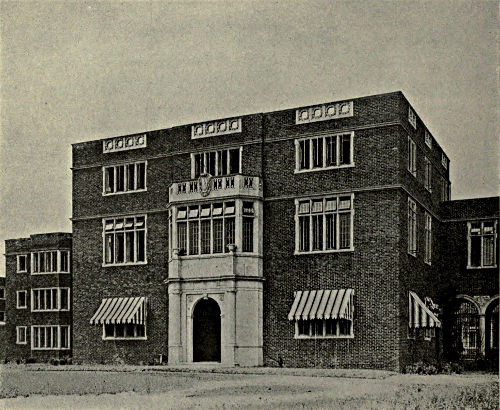
ADMINISTRATION BUILDING—ENTRANCE SIDE
They enter to the left, where they undress and bathe. Their clothes are tied up in a bag, temporarily placed in a metal-lined closet, which can be fumigated, and later taken to the general county farm laundry and sterilized. After the prisoner has had his bath he goes into the doctor’s office, where he is given a careful physical examination, and here also are made the finger-print and other records of identification which are very desirable from many points of view.
He then goes to the barber if necessary and has his hair cut. It is not now the custom to crop all prisoners’ heads unless the actual physical condition makes such treatment necessary. After he has been given clean underclothes and a clean prison suit he goes to the warden’s office and is there interviewed by him. The prisoner is told what the rules of the institution are, and his first meeting with the warden is of consequence to both, as it gives the warden an intimate opportunity to regard and to counsel his man, and the prisoner his first intimation of what is expected of him and what his treatment will be. After his interview with the warden the prisoner is placed in cell block 3 to stay during the period of observation, which is usually about two weeks. This is not only for the purpose of finding out what his physical condition may be, and to guard against the development of contagious disease, but also that the prison authorities may make the equally[Pg 49] important diagnosis of his mentality, from which is largely determined his future treatment.
This cell block set apart for the observation period of the inmate adjoins the administration building, and it is easy for the warden to be in frequent touch with the new men. An inmate who is only sentenced for a week or ten days would never leave this cell block, but would serve his sentence and be released from there. Men confined for a longer period, however, would be assigned to whatever classification seemed best after the observation period expires. In the reception building are also included the shower baths, twenty-seven in number, so that all the inmates of each floor may be bathed at one period. Shower baths are frequently put in the basement, about the worst possible place for them at all times, but especially in a prison. At Westchester no quarters of any kind were put in the basement. It was determined at the outset that all requirements should be accommodated above ground, a very wise provision for every prison building. Adjoining the shower room is a store room which would be small under ordinary circumstances, but in this instance there is a large general storehouse which will be maintained independently for the penitentiary and workhouse.
The school building contains four rooms with accommodations for 30 pupils in each school-room.
The mess hall has been laid out so that the prisoners will sit at the table in the ordinary way, facing one another, with alternate wide aisles for service. Feeding the prisoners in a large mess hall has now been generally adopted in this country, and is infinitely better than the continental system of feeding them in the cell. Man is a gregarious animal, especially when his waywardness has landed him in prison, and the old systems, which aimed at the solitary confinement of the prisoner and tried to reform him by opposing all the things which were natural to him, were as stupid as they were cruel.
Over the mess hall is the auditorium, large enough for all, with two stairways so that the inmates from cell blocks 3 and 4 may be separated from those in cell blocks 1 and 2, and the connecting corridor has been divided by mesh grilles, so that these two general classifications which are very desirable may be maintained.
The connecting corridor is not only advantageous in permitting all portions of the institution to be reached under cover, but has been very desirable as a place of recreation for the prisoners. It will be noted that it is cross ventilated by windows north and south and that, with its extended southern exposure, it makes a very satisfactory place for recreation and exercise in bad weather when the men cannot work outdoors. A signal advantage, too, arising from this type of plan is that the cell blocks on the second and third stories are lighted on all four sides because of the one story height of the connecting corridor. The cell blocks are not only closed off from the connecting corridor by a glass partition, but at each floor the corridor between the cells is again closed off from the stair hall so as to make the quarters for the men as quiet as possible. The intolerable banging, rattling, and reverberation of the usual steel cell in the huge modern cell block is one of the chief things to be said against it.
It will be noticed that the institution as planned resolves itself into three courts, all of which will be kept in grass and planting and will look as little like the usual prison enclosure as is possible to make them through gardening means.
In designing Westchester the dominant idea was to accomplish three things: first, to create an institution which would look as little like the conventional jail as possible; second, to give each inmate the privacy of a separate compartment; and third, to build a county jail that, without giving much more in appearance and accommodation than the old type, should not exceed it in cost.
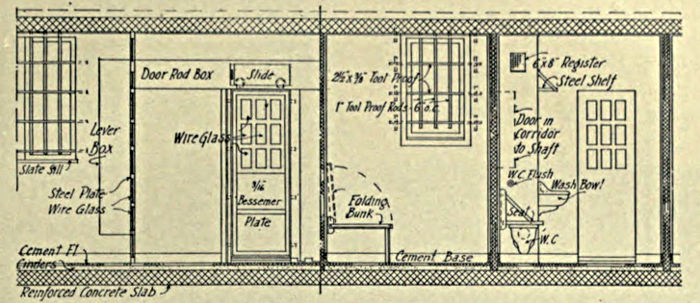
PLANS AND CELLS
ELEVATIONS OF CORRIDOR AND CELL
With the first idea in mind the bars to the windows were all located on the inside of the sash, instead of on the outside, so that this distinguishing mark of the usual penal institution should be as little evident as possible.
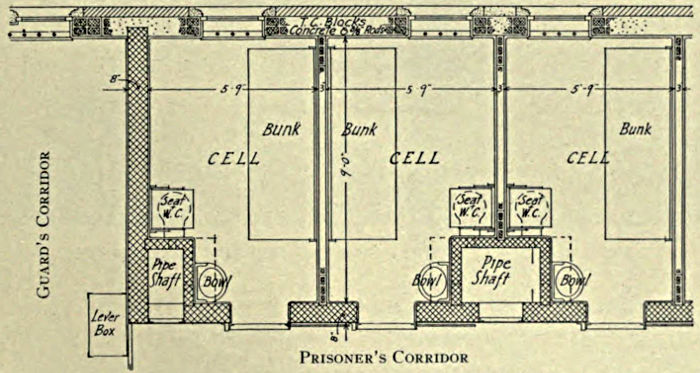
GROUND PLANS OF CORRIDORS AND CELLS
By a special dispensation of the New York State Prison Commission permission was given to place the bars six inches on centers instead of the usual four and one-half inches on centers. The windows were designed so that only three bars were necessary. These are painted light in color, and consequently offer much less obstruction to the light. They are of tool-proof steel, and as the inmates are all short-term men, the desire for escape is not so great as in the longer term prisoner. At the time this idea was developed the author would have hesitated to put long-term men behind prison bars which were so readily accessible to the ingenuity of the accomplished crook, but he would not hesitate to do so now.
In the cells a toilet has been placed where it will be screened as much as possible, and the usual prison seat has been arranged to close down over it and conceal it almost entirely from view. The cell walls have been painted a soft gray, and each cell has a cot, a table and chair, a shelf and hook for the prisoner’s clothes, and a wash-basin. The dining-room has been furnished with very creditable looking tables and chairs, and the floor paved with a[Pg 52] bright red tile, and the dull monotony of color usual in a prison building has been avoided throughout the institution.
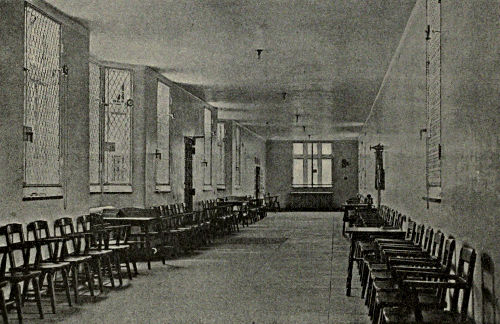
RECREATION CORRIDOR LOOKING TOWARD CELL BLOCK
In designing the Westchester County Penitentiary and Workhouse, the second ambition realized by the author was to give each prisoner an outside cell. When the plan was first developed, three years ago, the outside cell was much more a matter of controversy than it is at the present time. The inside cell of the American prison is a type peculiar to this country, and its design is based on the principle that the prisoner is to be retained above every other consideration. Consequently our jails have been designed with what has come to be known as “interior cells,” that is, the cells are placed not against the outside walls, but in the center of the building, back to back, separated by a passageway from three to four feet in width, referred to as a utility corridor, in which all the plumbing and ventilating pipes are placed. The space between the outside of the building and the front of the cells is frequently divided by a steel grille forming two long corridors, the outside corridor being called the guards’ corridor, and the inside corridor, next to the cells, the prisoners’ corridor. The object of this division was to protect the guard from the prisoner, for this system is devised on the theory that every jail building must be constructed on the basis of making it safe for the worst possible criminal which might ever get into it. Indeed, every once in a while a guard is killed by a prisoner; but so every once in a while a man is killed crossing the street, but this does not mean that our streets are unsafe, if reasonable care is observed in traversing them.
Placing the cells in the center of the cell block makes it possible to fill the outside wall with windows—in fact, a proportion of light area which came to be established was that the outside wall should be 50 per cent glass. The radiation was placed between the windows, which open like louvres, and with an exhaust fan in the top of the utility corridor it was possible to draw the warm fresh air through the cell to the roof, thereby obtaining very satisfactory results in heating and ventilation.
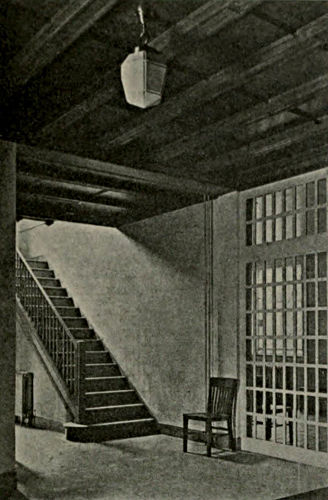
STAIR HALL, ADMINISTRATION BUILDING
While a good deal may be said for such a prison from the standpoint of its mechanical heating and ventilation, from the standpoint of the welfare of the prisoner hardly too much can be said against it. The great disadvantages of the cage type of cell are the complete loss of all privacy to the inmate, the inhuman and grotesque appearance which it gives to his confinement, and the difficulty of providing really adequate segregation and classification. Important prisons like the Great Meadow Prison of New York State and the prison at Stillwater, Minn., both of which are renowned for enlightened and efficient administration, have this inside cell arrangement. These prisons, however, were constructed when very little was known of the outside cell construction, and many practical prison men were largely against its adoption.
There is really no place in this country where it is possible to study adequately the outside cell, long advocated by our more progressive penologists, so that the author made a tour of Continental prisons for the sole purpose of discovering wherein lay their advantage and how they should be designed to make them suitable to this country and climate.
In the Continental prison the chief difficulty with the outside cell is found in its ventilation. In England the windows are intentionally made loose fitting so that they cannot lie entirely closed. Where it is possible to close the windows tightly, insufficient ventilation invariably results during cold weather because the great majority of prisoners seem to shun fresh air and invariably keep their windows shut.
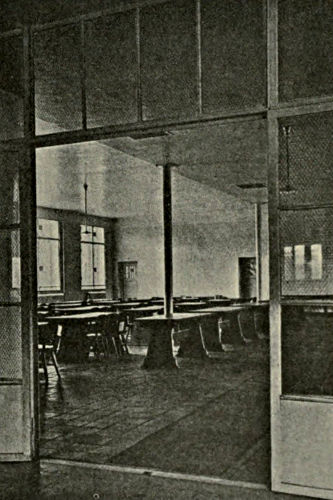
VIEW OF MESS HALL FROM CORRIDOR
Two methods are in use abroad for ventilating the outside cell, but neither is adequate. The English way is to build in the front wall of the cell a panel of special bricks which are made with diagonal or curved openings which will let the air through, but which will not permit the prisoner to see through. This arrangement is intended to ventilate the cell into the central corridor; but the central corridor is usually quite as much in need of ventilation as the cell itself. In the majority of English prisons the cell blocks are four tiers high, the cells being on the outside walls reached by galleries with the central corridor running clear through from main floor to roof. This is always bad, as such interior spaces[Pg 54] can only be lighted and ventilated through the roof; and while overhead lighting is always questionable, overhead ventilation is still more so. This condition is made worse as the cell block increases in length, and some of them, as at Pentonville, I think, are 175 feet long. This method of reaching the cells from galleries came about as a means of facilitating supervision, for the guard standing on the main floor has a view of all the inmates as they come out of their cells. As a matter of fact, the top galleries have very little supervision owing to their distance from the guard’s station. Better supervision is had and better discipline maintained when the cell floors run through, for then a guard may always be on the same floor with the prisoner. This arrangement also makes for better classification and greater quiet throughout the cell block.
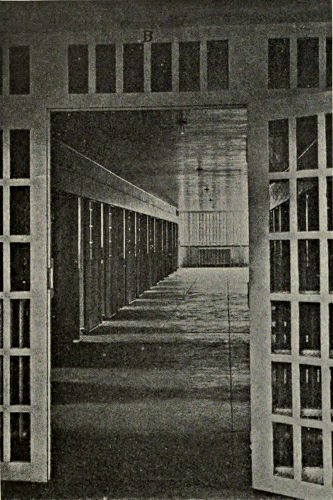
CELL BLOCK CORRIDOR
On the Continent, and in some of the older English prisons, the cells are ventilated by ducts or flues built in the walls, each cell with its separate flue, the registers of which are sometimes controlled by the guard from the corridor, but usually by the prisoner from the cell. The results of this method of ventilation, however, did not seem satisfactory to the author on the chilly February days when he was in Holland and Germany, for without exception he found the cell windows shut, in spite of the prison rules requiring that the prisoner shall always keep his window open.
Apart from this one point of ventilation, to the mind of the most casual visitor there can be no question that there is a great advantage in the privacy afforded by the outside cell. The doors are closed and the discipline and quiet of the prison are perfect. There are no cat calls through the night, nor is there the intolerable argument and vile language which are continually bandied back and forth in many American prisons, and particularly in our miserable county jails. This one thing, the lack of privacy, if there were no other, should condemn the inside cell system for all time. There is nothing in the suggestion frequently made that the outside cell is another name for solitary confinement, except where such a system is intentionally carried out, as formerly was the practice.
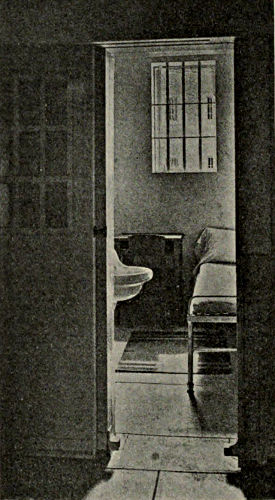
TYPICAL CELL
As our modern prisons are administered, the men are fed in a general mess hall and not in the cell, and[Pg 55] with the work on the farm and in the shops, and in the freedom which is now permitted in the recreation periods, there is not the slightest reason to feel that the inmate has anything to endure in the outside cell at all comparable to solitary confinement.
In New York State the regulations of the State Commission of Prisons are very precise on one point, and that is that each cell must have a toilet and a wash-basin. At Westchester vertical shafts were constructed between each pair of cells to contain all the plumbing pipes for those fixtures. The basins are designed so that the prisoner may drink from the flow of water, which is from the outside of the bowl rather than the wall side, thereby doing away with the necessity of a cup. The closet is suspended, fastened to the wall and not the floor, and equipped with a vent connected to galvanized pipes and ducts which are controlled by an exhaust fan, there being one fan for each cell block. This is a simple and effective way of providing against the prisoner’s habit of closing his window in the winter. The toilet has been placed behind the wall of the utility duct and is screened in that position. In the usual type of the inside cell block the closet is placed squarely in front of the door, with no screen whatever, and no effort seems to have been made to give it any privacy.
The cell doors operate on an automatic device, with which it is possible to open all the doors at once, or each one individually. The author’s contribution to this device was that they could also be locked five inches open. In this way it is possible in warm weather to ventilate the cell into the central corridor; which in turn is ventilated at each end by accessible windows across its entire width. It is true that the prisoners can look out through the five-inch opening and communicate with one another across the corridor; but if this privilege is abused, the door can be closed separately and the offending inmate may be disciplined without affecting the comfort of the others. In the new cell block at the Eastern Penitentiary at Philadelphia the cells have been equipped with two doors—one of solid wood and the other an iron grating. In warm weather the grating only is used, and if a prisoner becomes unruly or noisy, the wooden door is closed. The upper portions of the doors at Westchester are glazed, as they always should be, because it is necessary for the guard at all times to see if the prisoner is in his cell.
Almost the whole problem of the outside cell lies of course in the window. Our climate is such in summer that it would be almost inhuman to put a man in a cell and shut the door without providing adequate window area. The English cell with its small window opening would be intolerable here. So would those in the Holland and German prisons, where the windows are hinged at the bottom and open at the top. The Westchester windows are steel sash of the usual casement type except that they are pivoted top and bottom 4 inches from the jamb. This enables the window to be readily cleaned on each side. The window opens at right angles to the wall, and the opening is entirely adequate for our weather conditions, the window being two feet wide and four feet high. The adjuster is a commercial type, and will keep the window open at 90 degrees, 45 degrees, and about 15 degrees.
By Albert Kahn, Architect
The plan of the new Detroit House of Correction is the result of a careful survey of the most recently designed penological institutions and the assembling of what was considered best about them, adding such features as seemed desirable to the Hoard of Commissioners and its architect.
Foremost in the general scheme is the proper correlation of the various divisions, for administration, the admission, care, and education of prisoners; the workshops and recreation courts. With all, the idea of preserving the prisoner’s self-respect as far as possible and impressing him with the idea that while he must receive deserved punishment, every chance of rehabilitation is offered him.
A study of the plans will reveal the fact that the center wing houses, the administration offices, the receiving rooms for prisoners, the social service offices, and all departments general to the institution, such as visitors’ rooms, commissary rooms,[Pg 56] main dining-room, kitchen, main auditorium, chapel, hospital wards, educational rooms, and library. Thus located, they are close to the administrative center and make for easy supervision.
On both sides of the central wing are placed the cell blocks, connected by a corridor wide enough to serve as recreation space. By this arrangement privacy is assured the prisoners and freedom from the gaze of visitors to the more public departments of the institution. Ten cell blocks, five on each side, and each three stories high, afford opportunity for the segregation of prisoners, which is so essential. General baths and barber-shops are placed in the center of each group. The cell blocks in the main are of the outside type, though for the most hardened prisoners and for punishment some inside cells are provided. The floors, however, are entirely separated, the regulation cell block being avoided.
The prisoners enter by a private drive, and through one of the exterior courts, into the receiving room, which is adjacent to the social service offices and close to the administrative offices.
The kitchen and main dining-room occupy the extreme south end of the center wing, and the latter is accessible to the prisoners without traversing the more public corridors. Directly above the dining-room is placed the auditorium, with a stage, all equally accessible to the prisoners. Opposite the auditorium is the chapel. The second floor of the administration building is given over to the hospital, dispensary, etc.; the third floor to classrooms and library; also quarters for guards.
The Industrial Building forms the south group. It is planned along the line of modern factory construction, with concrete floors and ample daylight. It is arranged for progressive woodworking, the raw material being received at one point, passing[Pg 58] through the machines to the other end of the plant, then up to the second floor, and back to the shipping-room adjoining the receiving-room. Dry kilns of the most approved type and proper trackage for railway shipment are provided; also a garage for trucks and a machine shop.
The power and heating plant is located on the center axis north of the Industrial Building. The general laundry adjoins the heating plant. On the second floor of this building the gymnasium is placed. This building divides the open space into two courts for the recreation of the two classes of prisoners. Each court is adequate, in size for baseball and other games. The ground occupied rises considerably to the north, whereby opportunity is offered to keep the recreation courts fully 12 feet below the first floor level, and for a full basement, which affords ample and well-lighted space for the Commissary Department, tailor shop, shoe shop, and other shops and store-rooms of all kinds.
As will be noted, save for a short connecting wall, the buildings themselves form the enclosure of the courts, whereby forbidding walls are obviated.
The buildings throughout will be fireproof constructed, in the main of reinforced concrete, and faced on the exterior with tapestry brick. Spanish tile will be used for the roof of the center building. Such trimmings as occur will be of Bedford limestone. The exterior is treated in the character of Lombard brick architecture, which style lends itself particularly well to the problem. All ostentation has been avoided and architectural effect has been sought in the general grouping and proportions rather than in the ornamentation; nevertheless, the psychology of attractive buildings has not been overlooked.
Particular attention will be paid to the proper setting of the buildings and to the planting of trees and shrubs about them. Placed a considerable distance back from the main road, and partially concealed by trees and the undulating land, a certain degree of privacy desired by the Board will be secured.
The aim of the Board and its architect throughout has been to produce a group of buildings economical in construction and maintenance, though attractive and sanitary, and easy of supervision, while assuring the prisoners privacy and comfort. Through proper surroundings it is hoped to strengthen their manhood.
Maintained by the Board of Jewish Guardians at Hawthorne, New York
By Hastings H. Hart
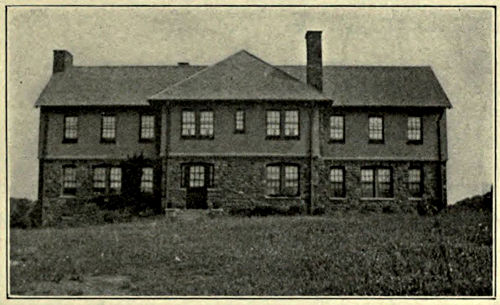
HAWTHORNE SCHOOL, HAWTHORNE, N. Y.
Reception Cottage
Harry Allan Jacobs, Architect
The Receiving Cottage of the Hawthorne School is an admirable example of a dormitory cottage for boys. We present herewith a photograph of the exterior, together with the first-and second-story plans.
The hall on the first floor terminates at one end of the house in the living-room, and at the other end in the dining-room, economizing space. The living-room has windows on three sides, and has an attractive fireplace. The dining-room at the opposite end of the cottage has also windows on three sides. The kitchen is so arranged as to give cross ventilation, both east and west and north and south, in hot weather. The first floor has also a small sewing room, with suitable storage.
On the second floor there are two dormitories, each containing 10 beds. Each dormitory is connected with shower bath, toilet, and locker room, so arranged that the day clothing of the boys is locked up at night. The second floor contains a commodious room for the matron, with bath and a room for a monitor.
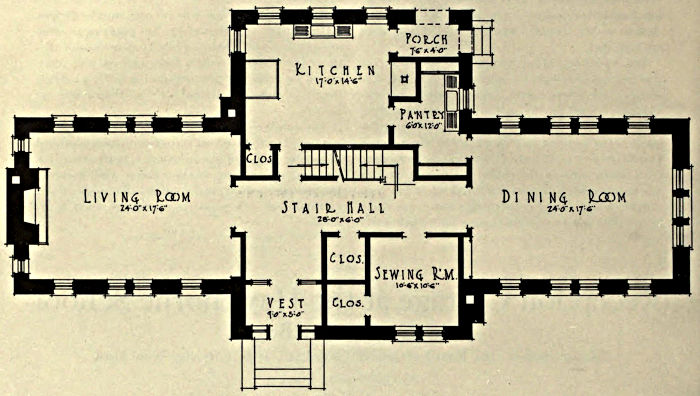
RECEPTION COTTAGE—FIRST FLOOR PLAN

RECEPTION COTTAGE—SECOND FLOOR PLAN
The arrangement of the cottage is such that there is not an inch of waste space and its appearance outside and inside is very attractive. The building is thoroughly well constructed, with excellent hardwood floors which are maintained in perfect condition after five years’ use.
The Hawthorne School has developed by the process of evolution, which has produced four types of cottages, each new one presenting improvements upon its predecessors. It illustrates the advantage of building institutions by successive steps in order to profit by experience.
By Hastings H. Hart
The Thorn Hill School is an institution for delinquent boys maintained by Allegheny County, Pennsylvania, and located at Thorn Hill, 20 miles north of Pittsburgh. When the school was instituted, in 1911, on the advice of the writer, two wooden shacks, without basements, with a capacity of 24 boys each, were built for temporary use. These buildings were well constructed, with floors of southern pine and were ceiled with southern pine, and equipped with good plumbing.
Soon after some excellent two-story brick cottages of modern construction were built. The superintendent said to one of the house fathers: “You have done so well in this temporary cottage that we intend to give you one of the new cottages.” The house father replied that he and his wife would prefer[Pg 62] to remain in the one-story cottage. This preference led to a study which resulted in the construction of three one-story brick cottages, two of which had a small basement under a part of the building, and the other had no excavation. The first two one-story cottages were planned by Mr. T. E. Billquist, architect, and have been in satisfactory use for a number of years.
The writer said to one of the cottage matrons: “You have worked in a one-story cottage and in a two-story cottage: which do you prefer?” She replied: “The one-story cottage is greatly to be preferred. The matrons in the two-story cottages are tired to death climbing up and down stairs. When they are upstairs, the boys are doing mischief on the first floor, and vice versa. But I can stand in the door of my room and can see the kitchen, the dining-room, the living-room, the porch, the dormitory, and the locker room, and it makes the work very much easier.”
We submit a photograph of the exterior and floor plan of a one-story cottage, which was built without any excavation. Heat was supplied by natural gas, which simplified the problem. The dormitory contained 20 beds and was readily overlooked from the adjoining room of the house father. The foundation and the floor were of concrete, and the superstructure of brick. A large part of the work of construction was done by the boys.
In the first two cottages small basements contain heating apparatus, lavatories, and playroom for stormy weather. All of these one-story cottages are attractive in appearance inside and out. The temporary one-story “shacks,” built in 1911, are still in use. They cost only $4,000 each.
The one-story plan is gradually coming into favor. At Mooseheart, the great institution for dependent children, maintained by the Loyal Order of Moose, they have adopted as a standard cottage unit a one-story cottage for 16 children, with two dormitories containing eight beds each.
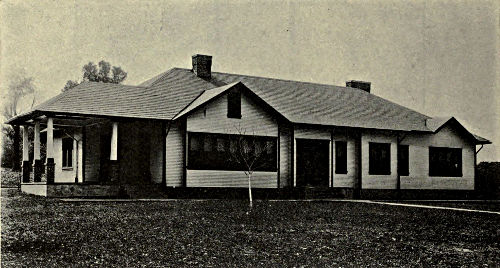
THORN HILL SCHOOL, WARRENDALE, PENN.—ONE-STORY COTTAGE
Designed by Franklin H. Briggs, Superintendent